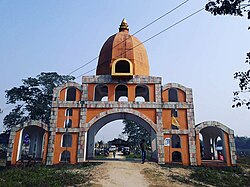Medieval period
Copperplates of land grants made in this region are those by the Chutia kings, that date back to the year 1392 AD when king Satyanarayan donated 600 puti of land to a Brahman named "Narayan Dwij" at Dhenukhana. [7] This was the time when the Ahom prince Sudangphaa was still living with his Brahmin foster family at Habung. [8] The copper plate of Chutia king Dharmanarayan dated 1428 A.D. mentions Sri Vrihat-patra as Habung-aadhipati (lord of Habung). The plate records land grants of 400 puti given to a Brahmin named Purandar Vipra, indicating that Habung was a principality of the Chutia kingdom. [9]
Suhungmung, the Ahom king, following an expansionist policy and annexed Panbari of Habung in 1512 AD, which was a part of the Chutia kingdom. [10] The Chutia king Dhirnarayan attacked the Ahoms at Dikhoumukh the next year, but was unsuccessful. The Chutias again attacked the Ahoms in 1520 and occupied the areas up to Namdang and Mungkhrang. [11]
The last copperplate recording a grant made in the region was issued by king Dhirnarayan in 1522 A.D. at a place known as Konwargaon (present-day Dhakuakhana) after which the region was finally annexed by the Ahom king Suhungmung in 1523 A.D. [12]
